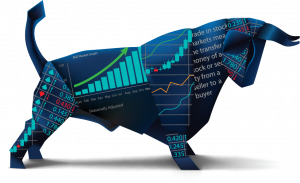Trading?
Trading is the buy-and-sell of assets. Buyers pay for goods and services. In other circumstances, parties exchange products and services.
Financial instruments are assets traded in financial markets. Stocks, bonds, Forex currency pairings, options, futures, margin products, cryptocurrencies, etc. We’ll define these concepts later in the article.
Short-term trading, where traders enter and exit positions over short time frames, is called trading. This is misleading. In truth, trading may relate to a wide range of different tactics, such as day trading, swing trading, trend trading, and many others. But don’t worry. We’ll detail each afterwards.
Investing?
Investing involves allocating resources (like capital) to make a profit. This includes funding a business or buying land to resale for a profit. Investing in financial instruments with the expectation of selling them later for a profit.
Investment means expecting a return (this is also known as ROI). Investing is more long-term than trading. An investor seeks long-term wealth (years, or even decades). Investors use basic criteria to locate investing possibilities.
Due to their long-term focus, investors don’t worry about short-term price swings. As a result, they’re usually passive about short-term losses.
Why trade vs. invest?
Financial market traders and investors both desire profits. Their approaches are distinct.
Investors seek returns over years or decades. As investors’ time horizons grow, so do their investment returns.
Traders exploit market volatility. Since they routinely enter several deals, they may seek smaller returns per trade.
Better? What’s better? You choose. You can learn the markets by reading and doing. You’ll learn which one suits your financial goals, personality, and trading profile over time.
What’s FA?
Fundamental analysis values financial assets. A fundamental analyst considers economic and financial elements to value an item. These can include macroeconomic variables like the state of the economy, industry conditions, or the asset’s business (if there is one). Leading and trailing macroeconomic indicators track these.
After the fundamental study, experts assess if the asset is undervalued or overvalued. This conclusion can help investors.
In the case of cryptocurrencies, fundamental analysis may also involve on-chain measurements, a growing subject of data science. These stats include network hash rate, top holders, addresses, transaction analysis, and more. Using public blockchain data, experts can develop complicated technical indicators to gauge network health.
Fundamental research is popular in the stock market and Forex, but it’s less useful for cryptocurrencies. This asset class is so young that there’s no established, comprehensive valuation framework. Speculation and narratives drive most of the market. Fundamental reasons rarely affect the price of cryptocurrencies. Once the market grows, more accurate valuation methods may be established.
TA is what?
Technical analyzers work differently. Technical analysis predicts future market behavior based on past price activity.
Technical analysts don’t value assets’ intrinsic worth. They look at prior trading behavior to find possibilities. This includes price movement and volume analysis, chart patterns, and technical indicators. This analysis evaluates the strength of a market.
Technical analysis isn’t just for predicting price fluctuations. It’s a good risk management framework. Technical analysis helps identify and measure transactions by evaluating market structure. Risk management begins with measuring risk. Some technical analysts aren’t just traders. They may utilize technical analysis to manage risk.
Technical analysis may be utilized on any financial market, including cryptocurrency. Technical analysis works? As we’ve said, speculation drives the cryptocurrency markets’ valuation. This makes them perfect for technical analysts, who can focus on technical factors.
Fundamental or technical analysis?
Your trading approach determines that. Use both! Most market analysis methods function best when combined. So, you’ll find more solid investing alternatives. Combining trading techniques helps reduce bias in decision-making.
This is confluence. Confluence traders integrate many methods into one. Combined techniques may offer better trading chances than one alone.
Cryptocurrency beginner? Binance Bitcoin!
What drives markets?
Supply and demand determine an asset’s price. Buyers and sellers decide. Supply and demand create markets. What else drives an asset’s value?
Fundamental aspects like the economy have been mentioned. Technical considerations include a cryptocurrency’s market capitalization. Market sentiment or news may also be factors.
These are only considerations. Supply and demand determine a given asset’s price.
Market trend:
A market trend is an asset’s price direction. Using price action, trend lines, or major moving averages, technical analysts identify market trends.
Bull and bear markets are the primary market trends. Bull markets have sustained price increases. A bear market is a persistent price decline. Consolidating or “sideways” markets have no apparent path.
Bitcoin price history
Bitcoin has always been bullish.
A market trend doesn’t necessarily indicate the pricing will follow it. A long bull market contains smaller bear tendencies, and vice versa. This is market nature. It depends on your time frame. Higher-time-frame market trends are always more significant.
Market trends can only be accurately predicted in retrospect. Hindsight bias is the tendency to believe you predicted an event before it happened. Hindsight bias can affect market trend identification and trading decisions.
Market cycle:
You’ve probably heard “the market cycles.” Cycles are repeating patterns or trends. Higher-time-frame market cycles are more reliable. You may identify minor market cycles on an hourly chart, just like with decades of data.
Cyclical markets. Some asset types outperform others during cycles. Due to market conditions, some asset classes may underperform in other sectors of the same market cycle.
It’s difficult to know where we are in a market cycle at any particular time. After that phase of the cycle ends, this analysis can be done accurately. Market cycles have fuzzy beginnings and endings. Being in the moment is a skewed financial market viewpoint.





